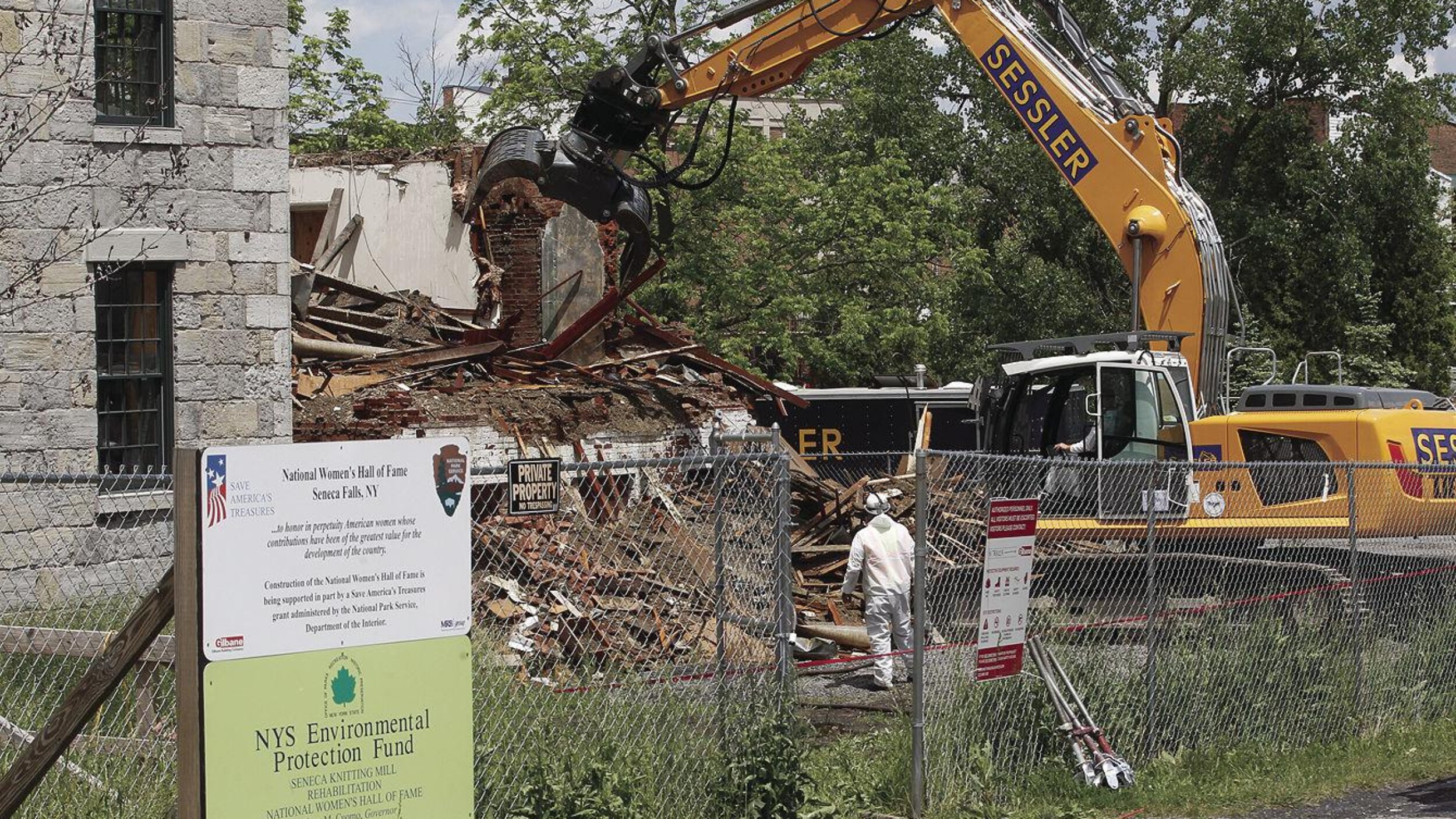Memories, Emotions Surface as Demolition of Seneca Knitting Mill Office Building Begins

By DAVID L. SHAW Finger Lakes Times
SENECA FALLS — As workers were getting ready to begin demolishing buildings around the former Seneca Knitting Mill Tuesday, Anne Marrapese Kaye of Seneca Falls paid an emotional visit to the site.
Camera in hand, she asked National Women’s Hall of Fame officials Jeanne Giovannini and Betty Bayer if she could see the inside and take some photos of the 1844 limestone mill building where her father worked from his teens until his retirement.
“I told her I understand,” Giovannini said. “My mother worked here for many years too.”
Kaye grew up on Toledo Street and her late father, Michael Marrapese Sr., would walk to work at the canalside knitting mill every day.
“My friends and I would walk downtown by the canal and my dad would look for us,” Kaye said. “He would be in a window of the knitting mill and would wave and yell to us. I remember that well.”
She wanted to see the inside of the main part of the old mill, the limestone structure that is being renovated into the new National Women’s Hall of Fame.
“Growing up, I remember being able to stand in the doorway of the mill and see the huge machines and the workers, hearing the noise,” she said.
Giovannini and Bayer gave her a hard hat and let her go from floor to floor with her camera.
“Dad worked here from when he was a teenager until he retired. It was big part of our lives,” she said.
Kaye knew that the Bridge Street bridge near the mill was where, in 1917, a young Italian immigrant named Antonio Varacalli jumped into the canal to save a woman from drowning after she jumped from the bridge in a suicide attempt.
He saved her but lost his own life, and his heroism is commemorated with a plaque and annual Antonio Varacalli Day ceremony.
Ironically, it was an incident that played out similar to one in her own family.
“In the early 1970s, my father saved a distraught woman who had jumped into the canal but didn’t want any publicity. The police chief at the time, Tony Casamassima, wanted to honor him, but he declined,” Kaye said.
“He worked from 6 a.m. to 6 p.m. This place has an emotional tug on me because he and so many others worked so hard for not that much pay,” Kaye said.
Wednesday, crews from Sessler Wrecking and Excavating of Waterloo began to tear down a brick, two-story office building on the east side of the limestone building, which will be the Hall of Fame’s new home.
Working with surgical precision and a machine with a claw-like attachment, the operator removed the middle of the building first to make room for the west side wall to be pulled inward.
The brick building is only about six or seven feet from the limestone building, and the idea was to avoid damaging the limestone and its new windows. The debris will be removed, and crews will move on to a large brick structure on the east side.
Workers spent Tuesday stabilizing the building in preparation for Wednesday’s demolition.
Last week, the town Planning Board and Zoning Board of Appeals met together and gave the Hall of Fame site plan and use variance approval.
“That will help us secure new grants and keep on with our fundraising efforts,” Giovannini said.
The final design is now being prepared so the Hall of Fame can be set up on the first floor in the first quarter of 2018.
“Removing the old brick sections will allow the beautiful limestone mill building to stand by itself, giving people a good idea of how the new Hall of Fame will look on this site,” she added.
When Sessler crews demolish and remove the debris from the west side, they will face the challenge of keeping the large smokestack intact so it can be incorporated into the final design.


